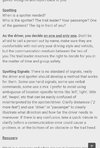- Location
- Grand Junction, CO
You are using an out of date browser. It may not display this or other websites correctly.
You should upgrade or use an alternative browser.
You should upgrade or use an alternative browser.
Topic of Discussion Trail Spotting 101
- Thread starter Greg
- Start date
I disagree with him. I think verbal commands are significantly better than visual. With visual, the spotted needs to be in sight at all times. If you are trying to watch a real axle, you wont be in sight as you are behind the vehicle.
Verbal commands also have a wider range in communication.. "front tire bumping up" "rear passenger tire dropping" ect.
He hand signals to go left. Is that a HARD left, or a SLIGHT left?
I vote voice signals. Not hand signals.
Besides all that... How am I supposed to hold a mountain dew if I am using hand signals??
Verbal commands also have a wider range in communication.. "front tire bumping up" "rear passenger tire dropping" ect.
He hand signals to go left. Is that a HARD left, or a SLIGHT left?
I vote voice signals. Not hand signals.
Besides all that... How am I supposed to hold a mountain dew if I am using hand signals??
I’m pretty chill when it comes to trail spotting and that’s partially because I tend to wheel with experienced people that don’t need help. In fact we usually just do our thing until somebody gets in trouble. Even then I may sit in my rig and yell driver or passenger haha
When I’m spotting an inexperienced person the level of my attention will be based on their needs. If I can tell they’re freaked out or really need help I will make a lot of eye contact and carefully explain what they need to do. Verbal communication is my go-to but if they need hand signals too that’s fine.
And if I’m out of my rig spotting and I don’t have a Dew in my hand that means I’m out of Dew and that’s sad.
When I’m spotting an inexperienced person the level of my attention will be based on their needs. If I can tell they’re freaked out or really need help I will make a lot of eye contact and carefully explain what they need to do. Verbal communication is my go-to but if they need hand signals too that’s fine.
And if I’m out of my rig spotting and I don’t have a Dew in my hand that means I’m out of Dew and that’s sad.
RockChucker
Well-Known Member
- Location
- Highland
The important thing is ONE spotter. If I’m spotting someone and another person jumps in, I’m out. I’m not going to compete and cause confusion.
Unimog
Eric
- Location
- Stansbury Park, UT
I agree with the hand signals, especially on a difficult obstacle or in crowded conditions. There are likely to be many "spotters" telling you what to do and you can easily disregard all the noise and watch the person you trust. This brings up the issue of too much help or not enough...
- Location
- Sandy, Ut
The important thing is ONE spotter. If I’m spotting someone and another person jumps in, I’m out. I’m not going to compete and cause confusion.
Agreed.
My personal discourse notes on the subject of spotting:

I perform/ assist with formal training classes with participants from very different experience levels, most recently it's been special forces military members doing 5-day mobility courses here in Utah using platforms many have never been in (HiLux, Surf & LC's). While many have spent time doing a basic driving course in a Humvee on a base, they've never been put in a manual transmission and told to drive up an icy rocky trail with even slight off-camber situations. Forming a spotter/driver trust level is massive and it starts with communication. We've all likely seen a driver spotter breakdown and yelling fest that is as entertaining as a husband/wife boat ramp combo
Last edited:
- Location
- Stinkwater
Watching the latest Grand Tour episodes, they were spotting eachother through some muddy rocky stuff and using terms like "left side down". I assume that means turn driver, but I'd never heard it before.
- Location
- Sandy, Ut
Watching the latest Grand Tour episodes, they were spotting eachother through some muddy rocky stuff and using terms like "left side down". I assume that means turn driver, but I'd never heard it before.
Yup, common rally/race language, ”left down one”, right down 3, etc. Works well with a co-driver more so than a spotter imo. Anytime you have a spotter moving from facing a vehicle to inline with the vehicle, left & right start getting distorted as muscle memory takes over.
- Location
- Stinkwater
Yup, common rally/race language, ”left down one”, right down 3, etc. Works well with a co-driver more so than a spotter imo. Anytime you have a spotter moving from facing a vehicle to inline with the vehicle, left & right start getting distorted as muscle memory takes over.
I solve that with "half a turn driver" or "quarter turn passenger". Sounds like this works well too though.
- Location
- Sandy, Ut
I solve that with "half a turn driver" or "quarter turn passenger". Sounds like this works well too though.
For sure, and I prefer your method as driver/passenger rarely gets confused.
